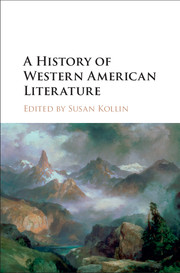Book contents
- Frontmatter
- Contents
- Notes on Contributors
- Acknowledgments
- Introduction: Historicizing the American Literary West
- PART I HOMELANDS
- 1 Indigenous Memories and Western American Literary History
- 2 The Recovery Project and the Role of History in Chicano/a Literary Studies
- PART II MAKING A REGION
- PART III GEOGRAPHIES OF THE LITERARY WEST
- PART IV THE TWENTIETH CENTURY AND BEYOND: LITERARY MOVEMENTS AND CRITICAL PERSPECTIVES
- Selected Bibliography
- Index
1 - Indigenous Memories and Western American Literary History
from PART I - HOMELANDS
Published online by Cambridge University Press: 05 November 2015
- Frontmatter
- Contents
- Notes on Contributors
- Acknowledgments
- Introduction: Historicizing the American Literary West
- PART I HOMELANDS
- 1 Indigenous Memories and Western American Literary History
- 2 The Recovery Project and the Role of History in Chicano/a Literary Studies
- PART II MAKING A REGION
- PART III GEOGRAPHIES OF THE LITERARY WEST
- PART IV THE TWENTIETH CENTURY AND BEYOND: LITERARY MOVEMENTS AND CRITICAL PERSPECTIVES
- Selected Bibliography
- Index
Summary
Indian Country
In a series of paintings instigated by the Columbus Quincentenary, Jaune Quick-to-See Smith (Confederated Salish and Kootenai) repeatedly reframes the map of the lower forty-eight United States through shifting, startling perspectives. One pair of paintings, entitled Tribal Map and Tribal Map II, replaces state names with the names of Indigenous nations in current “recognized” locations. The swath of states empty of Indigenous names, as well as the numerous names spilling across the borders of Oklahoma, invoke histories of forced removals and new homelands. At the same time, drips of paint that bleed the boundaries between states gesture toward the violent materiality of how those states were formed. Enlarging the frame to encompass hemispheric Indigenous presence, Smith includes text equations that compress histories of both continuance and containment: “Canada 2,250 reserves”; “American Indians Mexico 23.5 million”; “American Indians South America 20.4 million.” The names and numbers assert the hemispheric persistence of Indigenous peoples within geopolitical boundaries not of their own making. The dense narrative landscape of two other map paintings, Indian Map and Indian Country Today, papers the United States with newspaper clippings and photographs, illustrating the diversity and complexity of Indigenous experiences in the Americas.
Just as many state names are also Indigenous words, constant reminders of a history hidden in plain sight, Smith's maps also notably reference landmarks of Indian Country: In Memory Map, boldly colored petroglyphs move across and beyond the frames of the United States. In doing so, they visualize the foundational premise of Native studies: that everywhere is Indian Country. With these multiple invocations to remember, Smith also recognizes the continuing communicative power of Indigenous languages and expressive forms that mark specific, ongoing relationships to land, relationships that map political, spiritual, storied geographies. One of these paintings resides in the nation's capital at the Smithsonian American Art Museum. In the artist's statement that accompanies State Painting, Smith directs viewers on how to read her visual text of resistance and remembering: “I can't say strongly enough that my maps are about stolen lands, our very heritage, our cultures, our worldview, our being…. Every map is a political map and tells a story – that we are alive everywhere across this nation”.
- Type
- Chapter
- Information
- A History of Western American Literature , pp. 15 - 30Publisher: Cambridge University PressPrint publication year: 2015



